
“I always had a sense of peace when I went there. It was home because I never had a home.” –Donald O’Connor
In Singin’ in the Rain (1952), Cosmo Brown (Donald O’Connor) jokes that Lina Lamont (Jean Hagen) is a triple threat: she can’t sing, can’t dance, and can’t act. Luckily, O’Connor was just the opposite and quickly made a name for himself in the musical genre.
Donald David Dixon Ronald O’Connor was born in Chicago, Illinois, at St. Elizabeth Hospital on August 28, 1925. His parents, John and Effie O’Connor, were experienced vaudeville entertainers, with John’s family hailing from Ireland. Effie came from Decatur, Illinois, and left town to join a stock company. At age 14, she met Chuck Connors, who called himself John O’Connor. Like her, he left home to pursue a career in entertainment rather than end up working in the mines like his father. He was an acrobat, working as part of a tumbling act when he met Effie.
Though John was ten years older than Effie, they were married and soon created their own acrobatic act. Upon their marriage, they traveled with circuses like the Hagenback-Wallace and the Ringling Brothers. When the circus was not in season, they worked in vaudeville or in traveling tent shows. Effie participated as in ingenue in many skits and performed acrobatic stunts. By 1925, John and Effie had six children. Though three of the children died at an early age, another three survived: Jack, Billy, and Arline. The family performed in towns all over Illinois and the Chicago area, thanks to an old Reo Speedwagon that John rigged up for his family to take on tours. The wagon had bunks, lockers, lanterns, tables, a stove, blankets, cupboards and closets. The O’Connors would take this wagon all over the prairie–even through a Milwaukee snowstorm. This was the first home Don O’Connor knew.
Though one could argue that O’Connor grew up on stage, he was very much a presence off-stage. Effie would have a hard time getting him to fall asleep before her tumbling act would go on. Occasionally, it was difficult for him to stay asleep; Effie would occasionally spot the theater manager standing in then wings and waving to her, letting her know that her baby had woken up.
O’Connor made his stage debut as a toddler. He would sit in his mother’s lap while she played the piano. On another occasion, at the Kedzie Theater in Chicago, O’Connor wandered onto the stage in his diaper during a show. He threw is pacifier into the orchestra pit and started to stomp around the stage and sing “boom-pah-boom-pah” while the orchestra played. After that, he became a regular part of the family act. Furthermore, he joined the tumbling act as soon as he stopped using diapers. His brothers, Jack and Billy, would toss him around in their acts.
Despite becoming a singer and a dancer on vaudeville, O’Connor was never formally trained in either area. His family’s experiences in vaudeville and in the circus taught him all he needed to know in order to develop his own persona as an entertainer. One of his first dance routines was a team dance with his two brothers, during which he sang “Looking at the World Through Rose-Colored Glasses,” “My Mom,” and “Keep Your Sunny Side Up,” as soon as he could talk.
Tragically, when O’Connor was two years old, he and his sister were involved in a car crash when the O’Connors were playing at the Capitol in Hartford, Connecticut. His sister, Arline, was four years old, when she took O’Connor out in his baby buggy while Effie was ironing. They headed for the candy store across the street from the theater to satisfy her sweet tooth. Once she started to push his buggy across the cobblestones, she grew tired and left him parked on the sidewalk as she dashed across the street to the candy store. Arline was struck by a vehicle and did not survive.
Nonetheless, the show had to go on–especially to cover the funeral costs for Arline. The O’Connors continued their tour throughout New England. To make matters worse, his father would pass away a few weeks later from a heart attack in the middle of his tumbling act in Brockton, Massachusetts, during this tour. Once Effie quit performing, the new family act consisted of O’Connor, his brothers Jack and Billy, and a cousin named Patsy. Though O’Connor was an infant at the time, he felt very connected to these stories as he grew into “the toughest little kid in show business.”
While O’Connor was born in Chicago, the vast majority of his relatives lived in Danville, Illinois. His Uncle Will and Aunt Josie lived there in a big house, along with their 11 children. Uncle Will was successful in the plumbing business and had even been elected mayor before. Whenever the O’Connors did not have a booking or were low on funds, they would always return to Danville to be with family. To O’Connor’s delight, he would also have a myriad of cousins with whom he could play in Danville.
In Danville, O’Connor was seen as glamorous to his peers because he was a real stage actor. His friends would enjoy hearing stories about stage life or watching O’Connor perform magic and juggling tricks. While some of the boys would be jealous of the attention O’Connor received, many girls in town fell for him. Though the O’Connors would play at the Danville Theater and briefly enroll in public school, they would not stay in town all too long.
The O’Connor’s would also travel to Peru, Illinois, for respite. There, they would visit an old friend who ran the South Bluff Country Club. The family would earn their pay by entertaining at the country club or at the nearby Silver Congo. As a boy, O’Connor would occupy himself by shooting rats with a .22 rifle in old river front warehouses in La Salle-Peru.
After visiting Danville or Peru, though, the O’Connors would go right back to work. At the age of three, O’Connor worked in a tiny tuxedo and enjoyed walking around in the costumes he wore on stage as other children stared at him. Once, when performing in Lancaster, Pennsylvania, O’Connor wandered away from his mother and she called the police. A police officer later brought him back to her after finding him in his little tuxedo, singing in front of the Good Will Mission with the Salvation Army Band.
As O’Connor continued to grow, he needed to be educated. O’Connor would attend public school only for a few months on two separate occasions. Otherwise, his mother taught him the alphabet, multiplication, and anything else she deemed necessary in between shows in her dressing room. She utilized a correspondence course offered through the Pennsylvania Board of Education to educate her children. Effie would hold “class” each morning in her dressing room. O’Connor would work through his lessons while the rest of his family was putting on grease paint for the act. He would study on trains, in dressing rooms, in hotels, and in a wide variety of theaters, while his mother would mail back his work.
Behind the scenes, O’Connor was becoming quite the prankster. Occasionally, he would mix his mother’s rouge, powder, cold cream, and mascara together when she was not looking and would use the paste to paint pictures on the wall. In addition, O’Connor got into trouble when his mother discovered he had made holes in the women’s dressing room wall and spied on girls changing their costumes. He would also pick fights with other children just for the sake of having a fight. While playing at the Riverside Theater in Milwaukee, the theater manager was getting increasingly more upset at the fact that someone was stealing light bulbs all the time. Unbeknownst to the manager, O’Connor had no backyard to play in. Given that the theater backed up to a river, O’Connor swiped the light bulbs, tossed them into the river, and shot them with his bee-bee gun for amusement.
Though O’Connor’s performing abilities thrived, he encountered his fair share of dangers. During one act that called for mothballs to be spilled on the stage, a young O’Connor mistook them for candy and attempted to eat them. On another instance, he climbed a prop wall in a Chicago theater, fell, and injured his arm. Nonetheless, he held onto his arm and kept wiping off the blood until the act came to an end.
Another serious incident occurred when the O’Connors were performing at the State-Lake Theater in Chicago. Here, an audience member was snoring through their act, which was ruining their performance. Billy began to stomp his feet and Jack shot off a blank pistol, but the audience member continued sleeping and the audience laughed at the sleeper. Irritated, O’Connor left the stage to get a bottle of seltzer water and squirted it at the audience member’s face. The audience member got up, ran out of the theater, and sued the O’Connors and the theater management.
Since he started to work during his infancy, O’Connor had a strong sense of responsibility. This sense of responsibility was strengthened when his brother, Bill, traveled to Peoria for Christmas, contracted scarlet fever, and passed away four days later. O’Connor felt especially obligated to take care of his mother and did so as he embarked on a career in the film industry.
O’Connor made his screen debut in 1937 with uncredited roles in Melody for Two (1937) and It Can’t Last Forever (1937). Upon signing a contract with Paramount Pictures, he appeared in Men with Wings (1938) as a younger version of Fred MacMurray’s character and in Sing You Sinners (1938) as Bing Crosby‘s little brother. His succession of child roles continued with Sons of the Legion (1938), Tom Sawyer, Detective (1938), Boy Trouble (1939), Unmarried (1939), Million Dollar Legs (1939), and Beau Geste (1939). By 1940, he was considered too old to take on child roles and briefly returned to vaudeville.
In 1941, O’Connor signed on with Universal Pictures, appearing many B-movie musicals, including What’s Cookin’? (1942), Private Buckaroo (1942), and Give Out, Sisters (1942). In these films, he worked with the Andrews Sisters, Gloria Jean, and frequent co-star, Peggy Ryan. He starred with Jean and Ryan again in Get Hep to Love (1942), When Johnny Comes Marching Home (1942), and Mister Big (1943). Just before the release of Mister Big, Universal promoted the film to A-list status.
As soon as O’Connor turned 18, he was drafted into the United States Army. Universal expedited production on four more films, in addition to three more that were in post-production, so that they could have a substantial backlog of his performances while he was serving.
By 1944, he married Gwendolyn Carter, with whom he had a daughter. The couple divorced in 1954.
When O’Connor returned from the war, Universal had become Universal-International. The studio paired him with Deanna Durbin in Something in the Wind (1947). While he starred in several other films, he became a stable in the Francis films. These films depict the adventures of a soldier who befriends a talking mule. O’Connor followed Frances (1950) with five more films in the series. Aside from the Francis films, he frequently found himself starring in comedic roles.
By 1952, O’Connor was offered what would become his most iconic role–that of Cosmo the piano player in Singin’ in the Rain, alongside Gene Kelly and Debbie Reynolds. The film features his notable rendition of “Make ‘Em Laugh,” in addition to wonderful numbers like “Good Mornin'” and “Moses Supposes.”
Following the success of Singin’ in the Rain, O’Connor signed on for three films with Paramount. He continued making Francis films but also returned to MGM to work with Reynolds in I Love Melvin (1953). O’Connor worked in yet another musical named Call Me Madam (1953) alongside Ethel Merman and Vera Ellen for 20th Century Fox. O’Connor would reflect upon this film as one that contained some of his best dancing. Though O’Connor continued working in musicals and was poised to star as Crosby’s partner in White Christmas (1954), he unfortunately contracted an illness from the mule playing Francis and was replaced by Danny Kaye.
In 1954, O’Connor married Gloria Noble, and had three more children: Alicia, Donald Frederick, and Kevin. The would remain married until O’Connor’s passing.
Nonetheless, O’Connor’s film career continued with Anything Goes (1956) and The Buster Keaton Story (1957), in which he played Buster Keaton. O’Connor also transitioned to television with the short-lived Donald O’Connor Show and regular hosting duties for NBC’s Colgate Comedy Hour. In the 1960s, O’Connor starred in films in addition to working in theater.

The 1970s were turbulent for O’Connor. He suffered a heart attack in 1971 but overcame alcoholism near the end of the decade. Moreover, his career enjoyed a nice boost when he hosted the Academy Awards. He also appeared in Ragtime (1981), while continuing to make regular film, television, and theater appearances. In 1996, he had television guest roles in both The Nanny and Frasier. His last feature film would be in Out to Sea (1997), alongside Jack Lemmon and Walter Matthau.
O’Connor passed away due to complications of heart failure on September 27, 2003. He was 78 years old.
Today, there are several tributes to O’Connor and locations that would have been of relevance to him.
O’Connor’s birthplace, St. Elizabeth Hospital, is now Presence Saints Mary and Elizabeth Medical Center, Saint Elizabeth Campus. It is located at 1431 N Claremont Ave. in Chicago, Illinois.
The Kedzie Theater, where O’Connor wandered onto the stage, was located in the East Garfield Park neighborhood on W. Madison Street near N. Kedzie Avenue. It has since been demolished.

The State-Lake Theater, which house the notorious sleeping audience member, was located on the corner of N. State Street and W. Lake Street. Its interior was gutted and converted into studios and offices for the ABC network’s Chicago affiliate, WLS-TV.
The Riverside Theater, from which O’Connor would steal light bulbs, remains a concert hall. It is located at 116 W Wisconsin Ave in Milwaukee, Wisconsin, and is leased by the Pabst Theater Foundation.
The South Bluff Country Club, where O’Connor and his family would perform, remains at 229 N 2550th Rd. in Peru, Illinois.

In Danville, an outdoor wall mural, created by artist Andy Goretski, pays homage to six former Danvillians that became world-famous in the entertainment industry: Dick and Jerry Van Dyke, Gene Hackman, Donald O’Connor, Bobby Short, and Helen Morgan. The mural is on the north side of W. Harrison St., west of its intersection with N. Vermilion St.

The McDonald’s at 109 S Gilbert St in Danville, IL, takes note of its town’s stars. Dick Van Dyke is etched in glass and also memorialized on a bronze star.
Thanks to O’Connor’s many travels in his early years, he is certainly remembered in his self-proclaimed hometown of Danville and beyond.
This post originally appeared in the Annette’s Classic Movie Travels column for Classic Movie Hub. View the original article here.


















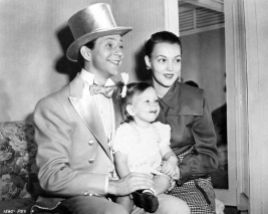






























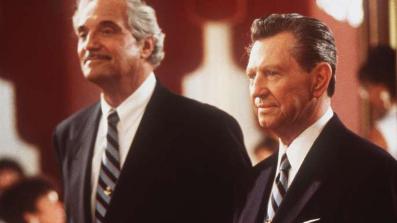
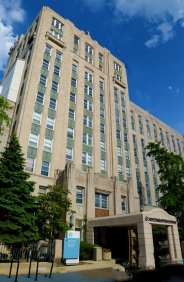






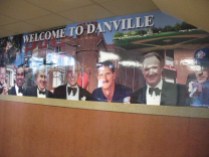

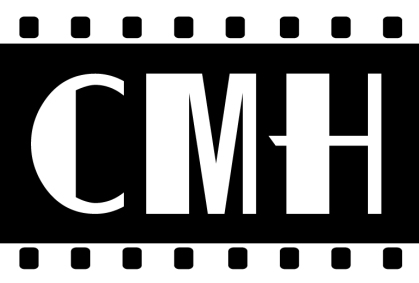






thank you…have always loved Donnie & was always sad that he never wrote an autobio…have learned about him thru reading Debbie Reynolds’ autobios & Janet Leigh’s autobio
Pingback: Grauman’s Chinese Theatre Forecourt | Hometowns to Hollywood
Pingback: 5 Favorite Films of the ’50s | Hometowns to Hollywood
Thanks for the informative piece filled and the little seen pictures. Very nice.
Pingback: Glen Haven Memorial Park | Hometowns to Hollywood
Pingback: Classics for Comfort | Hometowns to Hollywood
Pingback: Debbie Reynolds | Hometowns to Hollywood
I was watching There’s No Business Like Show Business and read up on Mr. O’Connor’s life. I’m glad he found happiness after enduring so much tragedy.